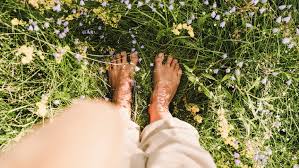Grounding—also known as “earthing”—is the practice of physically connecting with the Earth’s surface, often by walking barefoot or using conductive mats. While it might sound like a wellness trend, a growing body of clinical research suggests this simple habit could have measurable health benefits. Randomized controlled trials have shown that grounding may significantly reduce pain, fatigue, and inflammation. In studies on post-surgical patients, grounding was associated with improved physical function, reduced pain, and lower levels of inflammatory markers like CRP and creatine kinase (Oschman et al., 2015; Chevalier et al., 2013). One study of massage therapists found that grounding for six weeks improved physical energy and reduced pain long after the intervention ended (Chevalier et al., 2013).
Research also highlights grounding’s positive impact on sleep. A 12-week double-blind, placebo-controlled study found that patients with mild Alzheimer’s disease experienced improved sleep quality when grounded compared to a sham control (Kropotov et al., 2022). Other lab-based studies have shown that even short sessions of grounding—such as 1 hour using a conductive mat—can improve mood and emotional well-being (Chevalier, 2015). Physiologically, grounding has been shown to increase parasympathetic nervous system activity (your body’s “rest and digest” mode), improve circulation, reduce blood viscosity, and balance respiratory and cardiovascular function (Sinatra et al., 2017; Sokal & Sokal, 2011).
That said, grounding isn’t a miracle cure. Many studies are small, short-term, and more research is needed to fully understand how it works. Some experts suggest benefits may stem in part from increased time in nature, barefoot movement, or simply placebo effects (Oschman et al., 2015). Still, grounding is low-risk, affordable, and accessible. Whether it’s walking barefoot in your yard or using a grounding mat indoors, it may be a powerful addition to a healthy lifestyle. Combined with proven strategies like good sleep, regular movement, and balanced nutrition, grounding may offer a natural way to restore balance—literally and figuratively.
Chevalier, G., Sinatra, S. T., & Delany, R. M. (2013). Earthing: Health implications of reconnecting the human body to the Earth’s surface electrons. Journal of Environmental and Public Health, 2012, Article ID 291541. https://doi.org/10.1155/2012/291541
Brown, D., Chevalier, G., & Hill, M. (2010). Pilot study on the effect of grounding on delayed-onset muscle soreness. Journal of Alternative and Complementary Medicine, 16(3), 265–273. https://doi.org/10.1089/acm.2009.0399
Oschman, J. L., Chevalier, G., & Brown, R. (2015). The effects of grounding (earthing) on inflammation, the immune response, wound healing, and prevention and treatment of chronic inflammatory and autoimmune diseases. Journal of Inflammation Research, 8, 83–96. https://doi.org/10.2147/JI






